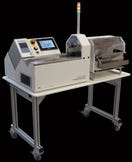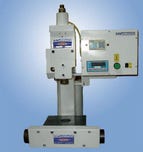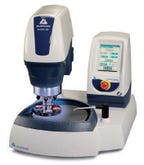May 25, 2010
 Fully Automated Catheter Tipping System Doubles Capacity
Fully Automated Catheter Tipping System Doubles Capacity
Tasks such as the loading of catheters and the cutting and loading of separate soft tips into the tipping process have traditionally been manual operations. Touted as the first fully automated system of its kind, however, an automated tipping system (ATS) doubles the capacity of the equipment involved, which can translate into cost savings by reducing labor costs and performing multiple processes per part. Produced jointly by two companies, the ATS draws from one manufacturer's Saffire RF tipping technology and the other's Accu-Cut tube-cutting and Accu-Feed tube-feeding technologies. Capabilities of the system include necking and flaring; singulation; assembly; precision cuts to length; and thermal bonding of two catheter materials for soft-tip applications. In addition to being intuitive and user friendly, the system produces clean, square cuts and precise lengths, according to the manufacturers.
Vante, formerly Sebra
Tucson, AZ
www.vante.com
ASG Medical Systems
West Palm Beach, FL
www.asgmedical.com
 Pneumatic Toggle Press Performs Stent Assembly
Pneumatic Toggle Press Performs Stent Assembly
A 3-tn medical-grade pneumatic toggle press has been customized to perform a crimping process for the assembly of cardiac stents. The Toggle-Aire model 1030 CSR-G2 is designed with a force-monitoring feature for strict quality control that validates press operation and provides interrupts, alarms, and documentation required for ISO compliance. Designed to ensure lot-to-lot consistency, the system's process controls can incorporate a variety of display and signal-conditioning devices to meet specific customer requirements. The standard press operates on 50 to 125 lb of air pressure with a controlled squeeze capability of more than 6000 lb at 100 psi.
AIM-Joraco
Smithfield, RI
www.joraco.com Measurement System Records Radial Forces of Stents
Measurement System Records Radial Forces of Stents
The head of a radial-compression measurement system can be fully submerged in a temperature-controlled water bath to replicate in vivo conditions for testing the radial strength and stiffness of stents. Because of this feature, the system yields more-realistic results compared with conventional flat-plate and V-block methods, according to its manufacturer. The RCM-60-WB uses a crimping head technology that ensures zero gaps and can accommodate a variety of head diameters and stent lengths. Demonstrating good repeatability, the system is suited for measuring the radial forces of stainless-steel, nitinol, and bioabsorbable stents. Its software allows users to generate custom test programs and can produce multiple data reports for easy comparisons.
Medical Product Technology Europe BV
Leek, Netherlands
www.mpteurope.com
 Coil-Winding Machinery Suited for Metal Catheter Fabrication
Coil-Winding Machinery Suited for Metal Catheter Fabrication
Offered in a range of configurations from benchtop models up to 12-ft-long systems, a line of coil-winding machinery can be employed in the manufacture of catheters. Capable of performing mandrel winding, mandrel coiling, and continuous winding, the systems can be supplied in manual, semiautomatic, and fully automatic versions; high-speed spindles can also be provided. They can wind a single filar or multiple filars of round or flat filaments. Bare or coated precious metals, stainless steel, and nitinol, among other materials, can be wound. In-line stress relieving or nitinol annealing is also available. Additional features include high-speed precision movements enabled by linear servo systems with 1-µm accuracy and programmable back angle and lead/lag sensing to adjust coil tension for droop testing.
Machine Control Specialists Inc.
Roselle, IL
www.mcsinc.com
 Grinder-Polisher Minimizes Surface Damage During Material Analysis
Grinder-Polisher Minimizes Surface Damage During Material Analysis
A grinder-polisher and associated power head are engineered to minimize surface deformation and damage during cross-sectional metallographic analysis of stents and catheters. Cross sectioning is performed in order to evaluate the device material's microstructure or to inspect coatings. In the case of drug-eluting stents, manufacturers must section the device without damaging the drug-polymer coating, for example. To prepare the sample for analysis, manufacturers first mount the device in an epoxy and then grind or polish the mount prior to imaging. When coupled with an AutoMet power head, the EcoMet grinder-polisher enables users to prepare the cross-sectioned samples in single or central force modes. It features touch screen controls and repeatable sample preparation.
Buehler, a div. of Illinois Tool Works Inc.
Lake Bluff, IL
www.buehler.com
You May Also Like


